
28 minute read
Congratulations
It was with some irony that I started at Menai Bridge in 1990 as I had originally gone to Bangor for a UCCA open day with a view to doing my degree there.
I remember it rained down all day during my visit, whereas during my visit to Swansea University it was glorious sunshine! I rest my case – Swansea it was. I did a degree in Oceanography; it’s funny because many people think I did my PhD in Bangor but in fact that was at Swansea too, and it was only after that that I got a post-doc contract with Colin Jago to study geophysical controls on mud erosion in a laboratory flume. The flume we designed and built during that time is still there and still used for teaching and research! I had a great time in Menai Bridge – what a stunning place – did all sorts of interesting things and made some good friends. Following post-doc stints in St Andrews University (estuarine processes) and Scottish Association for Marine Science (deep ocean biogeophysical processes), and a trip to the Arctic with the Ocean Drilling Programme (climate change research), I eventually surfaced to find a desert in terms of academic jobs and opportunities.
It was then I nervously moved into industry. Within a year (2003) I found myself with 2 relatively new colleagues founding Partrac Ltd, originally a specialist marine contractor with a niche operation in measurement of the physical marine environment (waves, currents, sediments and sediment transport, bathymetry and some geophysics). Partrac has now grown from such humble beginnings to be one of the leading global metocean survey and consulting firms, 30 strong with a capable, motivated and enthusiastic team behind operations. It’s not been all plain sailing, to be sure, and anyone who has started a company never really feels removed from the profound, pervasive pressure of providing first your own, and then the salary of others, every week, month and year! But we’ve done it, and in the processes completed many cool and challenging projects which include measuring sediment movements on Hawaii’an coral reefs, 3 summer’s of work in the Florida Everglades with alligators all around, pioneering offshore wind profile measurements in Europe and developing morphodynamic modelling tools to support asset integrity assessment for offshore wind developers. We now also have a consulting division, which complements and works with the survey side of the business, but also operates as a standalone body available for a range coastal projects.
Partrac was recently acquired by Venterra Group, an appropriate complement for all the hard work not only by the 3 Directors but by all those who have contributed to our success. For me, I look back now and whether academia or industry it’s all been about ‘people and places’; I have met, and worked with and for, many wonderful and inspiring people; at the same time I have had the distinct privilege of travelling the world, seeing life from a different perspective. When I was 18 I got a D in A-level chemistry which stopped me from going into medicine; thankfully – it’s been quite an adventure in oceanography (and one that continues)!

Vital Data | Valuable Decisions
It all started in the late 1970s with the first arrival of Steven Czitrom in graduated with a PhD in Physical Oceanography in 1982.
He was followed by the arrival of Maria Luisa Argote and Miguel Lavin who graduated with PhDs in Physical Oceanography in 1983 and 1984 respectively.
Around the same time, Des Barton was working in CICESE (the Center for Scientific Research and Higher Education at Ensenada), Mexico, in 1975-1979 before moving to Menai Bridge as a “young blood” lecturer in 1983. He started planning a project to study the wind-driven circulation in the Gulf of Tehuantepec, together with Oregon State University and CICESE. This collaboration started with his visit to CICESE in 1986, with a further visit by John Simpson in 1988.
I (Alex Souza) met Des and John during their visits, and they made the School of Ocean Sciences look like such an avantgarde institution and Menai Bridge such a brilliant place to live that they convince me to go there although I already had acceptance letters to other universities in the USA. I suspect that we all thought that it was a great opportunity.
These visits enticed not only me, but several of us to pursue our MScs and PhDs in Menai Bridge. As part of this group, the first wave consisted of Armando Trasviña, Victor Camacho-Ibar, Héctor Vélez and Adán Mejía, followed by Rubén Morales and Alex Souza, with the final arrival of Reginaldo Durazo. In 1989, Armando and Héctor were working on their PhD on the Tehuantepec Project with Des Barton, meanwhile, Victor was working on pollutants on Liverpool Bay sediments with Jim McEvoy, and Adán was working on his PhD modelling the Arabia Sea with Alan Elliot.
In 1989 Alex and Rubén started their MSc studies leading to projects on internal wave mixing in the Gulf of California (with Simpson) and water masses in the Indian Ocean (with Barton), respectively. In 1990, Reginaldo started his PhD working on the Irish Sea Gyre with Ed Hill CBE. Subsequently, Ruben and Alex stayed at SOS undertake PhDs on the Ocean Surface Mixed layer (with Barton) and Stratification in the Rhine ROFI (Simpson).
The last two students of this wave were Fernando Perez Castillo (with Paul Tett) and Miguel Angel Rio Portilla (Andy Beaumont) undertaking more biological PhDs. On completion of their PhDs all the Mexicans, with exception of Alex, returned to Mexico, to take up a range of different jobs at government institutions and universities.
Presently, Armando is a Senior Researcher at CICESE at La Paz, BCS; Héctor is a Lecturer at the Metropolitan Autonomous University (UAM-Iztapalapa) in Mexico City; Victor and Adán are at the Instituto de Investigaciones Oceanológicas (IIO-UABC) at Ensenada, BC; Reginaldo at Facultad de Ciencias Marinas (FCM-UABC) at Ensenada, BC; and Rubén at Instituto Mexicano de Tecnologia del Agua (IMTA) in Jiutepec, Morelos.
Alex Souza finished his PhD in 1994 staying as a postdoc in SOS until December 1997 moving on to the Department of Earth and Planetary Sciences at Harvard University, subsequently returning to the UK to the then Proudman Oceanographic Laboratory, now the National Oceanography Centre where he remained until 2017. He then returned to Mexico and is Acting Head of the Department of Marine Resources at the Centro de Investigacion y Estudios Avanzados (CINVESTAV). Following the initial wave many more Mexicans have come to study in Menai Bridge.
By Alex Souza and Rubèn Morales
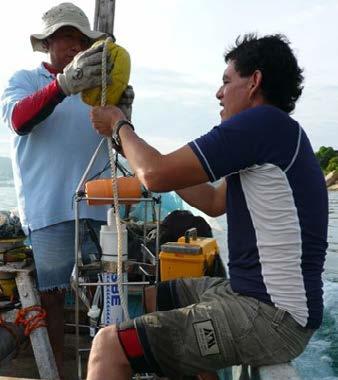
Rubén and Héctor doing deployment and CTD casts in Acapulco Bay (2008)
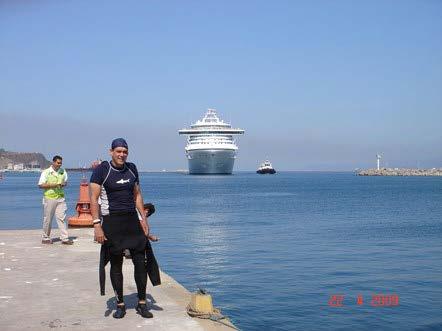
Héctor after an ADCP deployment in the Manzanillo Port (2009) Adán Mejia in Ixtapa-Zihuatanejo, México doing some ADCP measurements (2006)


Hector and Rubén in Ixtapa-Zihuatanejo, Mexico recovering and ADCP (2006)
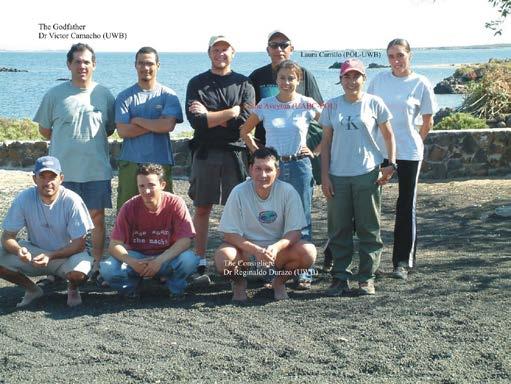
A few Years back Alex Souza and Reginal Durazo Working hard

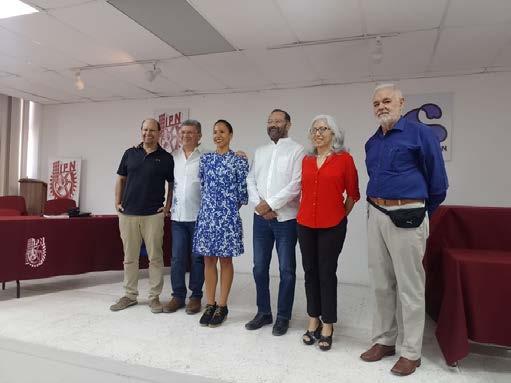
Armando Trasviña in a student viva
As a researcher at CICESE in Ensenada since 1979, I met Toby Sherwin (from Unit of Coastal and Estuarine Studies, now CAMS) during his visit in 1989.
He was invited by SOS alumni Miguel Lavín to teach a short course on pollutant transport in coastal waters. A couple of years later I spent a sabbatical year at UCES, at Toby’s invitation. It was here, under the supervision of Alan Elliott, that I got my first training in numerical modelling of the circulation in tidal waters. I met Des Barton again, who had been a researcher at CICESE a few years before, and John Simpson who had also visited CICESE.
At the time of my sabbatical, the first wave of Mexicans were already finishing their PhDs. By the end of my stay in Menai Bridge I had the opportunity to enroll as an external PhD student alongside my research position at CICESE. Sediment dynamics in the Gulf of California looked to be an interesting topic, since the Upper Gulf and the seas around UK had similarly strong tidal currents and resuspension of fine estuarine sediments. Sarah Jones and Colin Jago would be my supervisors. CICESE and Mexico’s Research Council (CONACYT), funded a research project in the Upper Gulf of California in 1996. The observations took place in summer of 1997 onboard CICESE’s research vessel.

Sarah Jones taking suspended sediment samples from the settling tubes.
Sarah and Dave Probert collecting water samples from the CTD frame. Dave Probert deploying a settling tube.
Sarah Jones and two Bangor undergraduate students (Dave Probert and Neil Fisher) participated in the 3 week cruise. Bangor transmissometers, settling tubes, particle analyser and filtering equipment were shipped to México (not an easy task!) to be deployed together with CICESE’s current meters, pressure sensors, CTDs and optical backscatters. It was an exciting experience for everybody onboard the crowded small vessel, under summer temperatures around 38 ºC, but pleasant water temperatures of around 30 ºC. The intense work at sea was interrupted once in a while by inspections by navy boats looking for illegal fishermen and smugglers in these waters, which are part of an ecological reserve area.
Dave and Neil wrote their BSc projects and I defended my PhD dissertation in 2003. Ocean Sciences provided good friends and an inspiring academic and natural environment which are unforgettable for me and my family (my children were students at Ysgol David Hughes). Back at CICESE, I continued data analysis of data gathered on our cruise. Additional BSc and a MS dissertations were also completed by CICESE students. My work remained focused on the Upper Gulf, including tidal flat sedimentation, gravity currents, seabed morphology, inverse estuarine processes and oceanographic assessment for artificial reef projects until my retirement from CICESE in 2017.

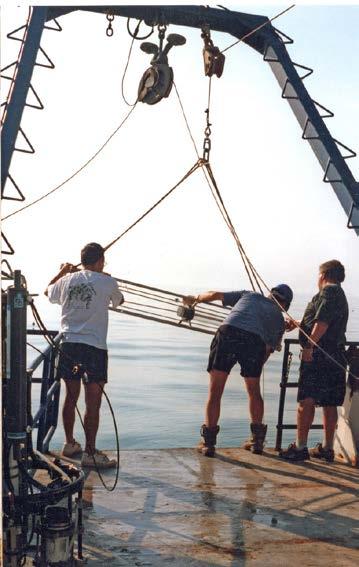
Professor Stuart A. Cunningham (M.Sc. Physical Oceanography, 1990)
Reading the Alumni news in The Bridge the affection we all have for SOS and the life it made possible for us is very clear.
I came to Menai Bridge in 1989 to work on my M.Sc. thesis (Hydrography of the Clyde Sea and the Clyde Sea Front), supervised by Dave Bowers and held to account by Des Barton. I had my first ever research cruise on the R/V Madog sailing from Menai Bridge to the Clyde Sea for a week of oceanography. Principle Scientist Tom Rippeth our illustrious editor was one of those tutoring me, keeping me safe and probably trying to keep my enthusiasm to realistic levels. They set me ashore in Loch Striven and I hiked over the hills to the main road and caught a bus to Glasgow! I thought then and still do that being a seagoing oceanographer is the most exciting and adventurous thing I could do with my life.
This set me up for my first professional job as a Research Assistant working at the Institute of Oceanographic Sciences Deacon Laboratory which I started on 5th November 1990. This was at the start of the World Ocean Circulation Experiment – a defining step change for the subject of physical oceanography. Thinking back, it was an incredible opportunity to sail the world’s oceans contributing to a global experiment. I completed a Ph.D. part time with the University of Liverpool during that time, working my way up the ranks as a NERC scientist. In 2012 I moved back to Scotland to work at the Scottish Association for Marine Science. I have now participated on 35 deep-sea research cruises (leading about half of those) on 14 different research ships from all over the world. I have worked in the Antarctic and crossed the Southern, Indian, Pacific, South and North Atlantic oceans. Strangely, one of my most enjoyable cruises was in 2020 when I led RRS Discovery Cruise DY120 in the midst of COVID restrictions. Lots of hassle to plan but once we got safely to sea it was a real touch of the normal.
For the past two decades the science I have pursued is measuring and understanding the Atlantic Meridional Overturning Circulation. The AMOC is a central component of Earth’s climate and moves heat and property fluxes around the globe. One of the major predictions of climate change in the 21st Century is a slowing of this circulation and this will have profound impacts on how Earth’s climate changes. I was one of three PIs who proposed RAPID mooring array programme (https://rapid.ac.uk/) and I managed the array from 2003-2012. Now I am PI as part of the international OSNAP programme (https://www.o-snap.org/) measuring the AMOC from Newfoundland to Greenland to Scotland. The goal of these arrays is to provide the fundamental observations of the changing AMOC so we can better understand the physics of the circulation and to constrain models of climate (Figure 1).
I am inspired to work on large multi-national programmes and no life could be more fun or let me meet and collaborate with so many brilliant people – and it all started in Menai Bridge.
Professor Stuart A. Cunningham Scottish Association for Marine Science & The University of the Highlands and Islands Stuart.Cunningham@sams.ac.uk
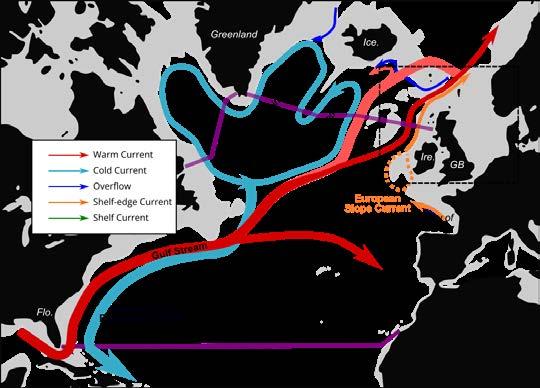
The large-scale circulation in the North Atlantic. A system of warm, northward flowing currents and cold southward flowing currents is known as the Atlantic Meridional Overturning Circulation or Gulf Stream System. The location of Stuart’s RAPID and OSNAP arrays of moored instruments for observing the AMOC are shown in purple.
World’s Lakes Experience Excess Warming
[pictures of frozen lakes (maybe in Snowdonia?).
More than half the world’s 117 million lakes experience ice cover for part of the year. But with the rise in global temperatures, the timing of seasonal ice formation and loss are changing at rapid rates.
More than half the world’s 117 million lakes experience ice cover for part of the year. But with the rise in global temperatures, the timing of seasonal ice formation and loss are changing at rapid rates. Since 1979, the average timing of lake ice break-up across the Northern Hemisphere has advanced by 8 days. This 8-day advancement has resulted in excess lake warming with numerous implications for lake ecosystems.
A new paper published in Nature Communications by Dr Iestyn Woolway of Bangor University and colleagues at Peking University has concentrated on Northern Hemisphere lakes, using satellite images to study nearly a thousand lakes and modelling over 100,000 to calculate the effects of the increased ice-free days on the water temperature.
They also suggest how changing temperature profiles within lakes might affect the processes within the lakes as well as the plants and animals living within the lake environments.
“Projecting future lake warming due to changes in ice cover is important for understanding how these changes could affect ecological processes within lakes, and how that will affect all the ways we, and other animals and plants use lakes in the future,” explained Dr Iestyn Woolway of the University’s School of Ocean Sciences.
“Higher lake surface-temperatures due to shorter periods of ice cover can impact processes within the lakes, leading to effects such as increasing or earlier plankton blooms, and increase in cyanobacteria and an increase in layering of different water temperatures. Water stratification could lead to lake deoxygenation [low oxygen concentrations] at depth, and loss of habitat for oxygen-sensitive fish,” he added.
Iestyn and his fellow researchers estimate that lakes will be ice-free around a month earlier (15-45 days in the northern hemisphere), which may lead to an increase of between two and six degrees additional surface temperature (during the ice-off month, the time of year in which dormant species begin to thrive once again) this century. They have also estimated that the 8-day advancement in ice break-up has resulted in an excess warming of 1.1 ± 0.9 °C during the month of ice-off.
Smart Technology Aids Research Into A Nationally Important Seabird Colony
UK scientists are rolling out an array of technology to understand if a charismatic seabird species will thrive or suffer under future climate change and extreme weather events.
The research, led by scientists from Bangor University, focuses on a national important colony of European shag (Gulosus aristotelis) on Puffin Island, near Anglesey. Numbers of European shags have been declining in recent years, putting them onto the red list of birds under the highest threat of extinction in the UK.
GPS trackers, accelerometers, miniature bird-borne cameras and time-lapse photography are some of the technologies being used by the team, which includes researchers from Lancaster University and the Universities of Liverpool and Cumbria. The footage from the miniaturised cameras captures the birds diving for fish, providing data to help researchers understand how weather conditions may affect the foraging behaviour and success of a diving seabird species. The research is the first time this technology has been used on seabirds on Puffin Island.
The accelerometers – a kind of speedometer – record how fast the bird is moving and how it twists and turns in the sea in pursuit of prey.
Ocean Sciences PhD student Claire Carrington, presented the research at the International Seabird Group Conference in Cork. Commenting she said: “We piloted the technologies on European shags on Puffin Island this year and they worked really well, so we’re aiming to fit them to more birds next year. We’ve chosen to work with the European shags, as they are particularly vulnerable to the impacts of extreme weather and remain in coastal areas year-round. The data we’re collecting will give us insights for both shags and similar diving birds such as the Great cormorant.”
They hope that the data will help them to understand how the European shag and Great cormorant, will respond to different weather conditions and predict whether they will be resilient enough to cope with the more extreme weather brought on by climate change.
Time-lapse cameras which take photos every 30 minutes are also installed all year round at key roosting sites around the North Wales coast, where the shags and cormorants dry their feathers off after fishing. Neither bird has totally waterproof plumage. This helps them to dive, by reducing their buoyancy, but means that they have to dry their wings after diving. The researchers are collaborating with computer scientists from Bangor University to develop bespoke software to automate the counting of seabirds, in thousands of images.
Lead researcher Dr James Waggitt said: “Cormorants and shags are very recognisable, and many people will have seen them around the coast, drying their wings out on the rocks. But although they are a common sight, their populations are still at risk in the UK, which is why it’s so important to better understand the threats they face and how they are responding.”
During the breeding season, other time-lapse cameras, taking pictures every ten minutes, have also been installed at nests on Puffin Island to see how regularly the birds are returning to feed their chicks.
Protecting and Regenerating Tropical Mangroves
Dr Martin Skov is involved in carbon offsetting work in Kenya.

Mangroves from the air photo credit: Vanga Blue Forests Project, GRID-Arendal. This work builds on a long-term partnership between Dr James Kairo of the Kenyan Marine and Fisheries Research Institute (KMFRI), Prof Mark Huxham of Edinburgh Napier University, Dr Martin Skov of Bangor University, and other colleagues. The partnership set up the world’s first carbon-trading projects arising from the protection of a marine system. The Mikoko Pamoja (meaning Mangroves Together in Swahili) community project in southern Kenya was accredited in 2013 and has won multiple awards. A second project, Vanga Blue Forests, has since been created and more are under way. The team set up the ACES charity to manage the trading of carbon credits arising from the protection of mangroves and to promote conservation projects with coastal ecosystems in Africa. For more information, see the ACES website.
Mangroves occur worldwide in the tropics, especially within 5 degrees as the equator, known as blue carbon ecosystems, they are home to saltwater marshes, seagrass prairies, and marine forests. Mangroves are vital to climate change. They cover only 0.1% of the earth’s surface but capture and store almost 5 times more carbon than rain forests. When trees on land due they release carbon into the atmosphere, with mangroves however, carbon is trapped in the roots and mud where it can stay, under water for thousands of years.
Mangroves were once seen as inhospitable malarial swamps and were among the fastest disappearing habitats in the world. Now thanks to investment and projects such as Mikoko Pamoja organisations are paying for the Planting and conservation of mangroves, in order to offset their carbon. This doesn’t only help the mangroves; it helps local communities thrive and is an example of the world-changing work done at Bangor University.
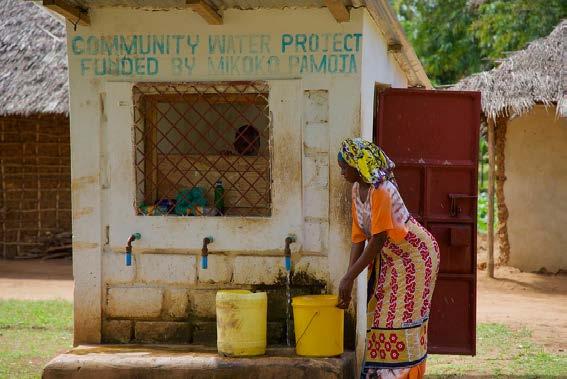
‘Water Point’ This photo exemplifies a community benefit from the Mikoko Pamoja project: public water points installed in the village. Women and children used to have to walk a long distance for water, and then the original well system collapsed. There was no water at the School in Gazi. The project has helped with that as well. photo credit: Vanga Blue Forests Project, GRID-Arendal.
Understanding How Extreme River Flows and Sea Levels Could Provide Early Flood Warning
New analysis of exactly how long extreme rainfall takes to drain from catchment to coast could lead to better identification of the coastal areas most likely to flood and provide timely flood-warnings in the future.
A new research paper in Estuaries and Coasts published by Post Doc Researcher Charlotte Lyddon, her supervisor Pete Robins, and others, provides the first step in improving coastal flood risk by analysing in detail, how long different UK rivers take to discharge to the coast following heavy storm rainfall. This is combined with an analysis of differing estuary types, to see which estuaries are most likely to impede the floodwaters from entering the sea, due to their shape and size. Finally, the paper considers the likelihood of the river flood-waters coinciding with a storm surge (a storm often produces both heavy rain and strong winds that drive the surge) or high tide at the coast.
Matching flood flow speeds and timings in different rivers with an understanding of which estuaries are most likely to experience storm surges, or when they might coincide with spring tides, could inform future flood protection measures. Such analysis could be valuable as the UK anticipates future extreme rainfall to intensify in the coming decades.
Previously, flooding has been investigated using daily-mean river flows, but this new work has shown that the many short and steep river catchments on Britain’s west coast drain rapidly, within a matter of hours, meaning that the daily-means mask out the extreme river behaviour that drives the flooding. This information will help climate modellers to produce future river flow projections at the appropriate temporal scales to predict changes in flood risk.
Peter Robins, Senior Lecturer in physical oceanography explains,
“Most heavy storms and winds track-in from the Atlantic and hit the west and northwest coasts of Britain. In addition, the west coast catchments are mostly small and mountainous. This means that they fill up and drain out to the sea remarkably quickly, perhaps within a few hours. These catchments therefore tend to experience several potential ‘compound flooding’ events each year, with the chance of flooding actually happening being sensitive to the subtle timings of the combined river and sea level behaviour.
Over in the east, the catchments are often large and flat and take several days to drain. Here, flooding tends to be driven by either prolonged periods of heavy rain, or from easterly storm surges, but rarely both combined. These extreme events are less common and more predictable than in the west.”
A classic local example is the Conwy Valley, where this autumn the BSc Physical Geography and Oceanography students got to see river flooding, and flood mediation efforts in full force on a visit to Llanrwst during their Geohazards Flooding field trip

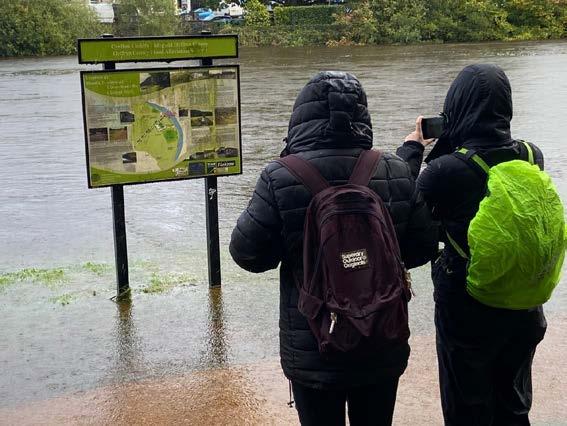
Attending the Coral Reef Ecology course at BIOS – by Thea Moule (MScRes Marine Biology student)
Before entering academia, I worked across the world in the SCUBA diving industry, from Australia to Mexico.

During this time, I experienced first-hand anthropogenic and climate impacts on tropical coral reefs, igniting my passion for a research career focused on coral reef ecology. I later enrolled on a BSc in Marine Biology and an MScRes in Ocean Sciences at Bangor University, completing an undergraduate dissertation and postgraduate thesis centred around tropical coral reefs. Since my research was desk-based and my academic studies took place in a temperate region, I was eager to obtain relevant field and laboratory experience on tropical coral reef systems. Therefore, I was immensely grateful to my sponsor through the U.K. Associates of BIOS for the full scholarship, supporting my attendance on the Coral Reef Ecology Course (CRE) at the Bermuda Institute of Ocean Sciences (BIOS). Here, the Director of University Programs & Associate Scientist at BIOS, Dr Andrew Peters, was a former undergraduate student from Bangor University.
The CRE course, held from August 8th to 26th, was co-led by distinguished researchers at BIOS, Dr Eric Hochberg and Dr Yvonne Sawall, and taught around twenty international students, ranging from undergraduate to doctorate level. The evening before the course started, an icebreaker session held at the onsite bar, ‘The Wind’, provided a relaxed setting to meet faculty staff and the other students while enjoying a few drinks. Throughout the course, our schedule was filled with lectures, underwater visual census surveys, experiments in the field and lab, and delicious food freshly made by the onsite chefs. The practicals included a gas flux experiment in the flume, gradient flux equipment in the field, and various underwater survey techniques (e.g., imaging for photomosaics, quadrats, and point-intercept transects) to record benthos composition. During data collection, we were organised into groups and allocated specific tasks, including shifts on the flume, and alternating between the underwater survey techniques. Although all the practical elements were interesting, my favourite was photogrammetry. This approach involved repeatedly swimming up and down, both the length and width of a marked area, with an underwater camera, collecting hundreds of images of the benthos. The images were uploaded onto a system in the dry lab, creating a point cloud, a dense cloud, and photomosaic. It was a very satisfying process that produced beautiful images of the coral reef. During the last week, we collaborated in groups to conduct data analysis based on a research topic of interest from the data collected. We presented our research findings to the class on the final day of the course. For example, in the group I was a part of, our presentation was titled ‘Benthic community assemblages of functional reef groups’. Overall, the course was an incredible opportunity to advance my knowledge in reef-functional ecology, obtain fundamental skills in data collection of reef community processes, and network to establish industry connections for future opportunities.
Outside the CRE course, I took the opportunity to explore Bermuda, which was readily accessible by bus. Activities included recreational SCUBA trips with the local dive shops, snorkelling at the pristine white beaches, swimming in caves, and enjoying the architecture in Hamilton. I also attended the infamous Harbour Nights held in Hamilton, a fabulous evening full of music, local dance performances, and an array of market stalls and food trucks. During evening visits to Whalebone Bay, a short walk from BIOS, I was fortunate to encounter two eagle rays swimming near the shoreline and witnessed the phenomenon of the marine glow worms, who make an appearance two nights a year. These were all incredible experiences alongside the course.
Each year, BIOS offers a variety of ocean science courses aimed at undergraduate and postgraduate students, including Ecology of Reef Fish, Marine Pollution and Ecotoxicology, Modern Observational Oceanography, and Research Diving Methods, to name a few. Typically, the summer courses are advertised on the BIOS website at the beginning of the year. During the application process, students from the U.K. are eligible to apply for a scholarship through the U.K. Associates of BIOS to support their attendance. Overall, I highly recommend SOS students consider applying for such an incredible opportunity to advance professionally.

(June - November 2022)
Selective foraging behavior of seabirds in small-scale slicks
Lieber, L., Füchtencordsjürgen, C., Hilder, R. L., Revering, P. J., Siekmann, I., Langrock, R. & Nimmo-Smith, W. A. M., 8 Nov 2022, In: Limnology and Oceanography Letters.
An Ice-Ocean Model Study of the Mid-2000s Regime Change in the Barents Sea
Barton, B., Lique, C., Lenn, Y-D. & Talandier, C., 1 Nov 2022, In: Journal of Geophysical Research: Oceans. 127, 11, e2021JC018280.
Microplastics alter multiple biological processes of marine benthic fauna
Mason, V., Skov, M., Hiddink, J. G. & Walton, M., 1 Nov 2022, In: Science of the Total Environment. 845, 157362.
Spatial and Temporal variation of size at maturity in an intensive crustacean fishery with limited management
Moore, A., Delargy, A., Cann, R., Heney, C., Le Vay, L., Lincoln, H., McCarthy, I. & Hold, N., 1 Nov 2022, In: Fisheries Research. 255, November 2022, 106450.
Lakes in Hot Water: The Impacts of a Changing Climate on Aquatic Ecosystems
Woolway, R. I., Sharma, S. & Smol, J. P., 30 Oct 2022, In: BioScience. 72, 11, p. 1050-1061 12 p.
Crisis Ocean Modelling with a Relocatable Operational Forecasting System and Its Application to the Lakshadweep Sea (Indian Ocean)
Shapiro, G., Ondina, J., Poovadiyil, S., Tu, J. & Asif, M., 25 Oct 2022, In: Journal of Marine Science and Engineering . 10, 11
The influence of tides on the North West European shelf winter residual circulation
Tinker, J., Polton, J., Robins, P., Lewis, M. & O’Neill, C., 12 Oct 2022, In: Frontiers in Marine Science.
Why is there a tide?
Ward, S., Bowers, D., Green, M. & Wilmes, S-B., 7 Oct 2022, A Journey Through Tides. Green, M. & Duarte, J. (eds.). Elsevier, p. 81113
Workshop on the Celtic Seas Ecoregion Aquaculture Overview
O’Biern, F. (ed.), Ojaveer, H. (ed.), Boyd, A., Capuzzo, E., Devine, G., Moore, H., O’Carroll, J., Dennis, J., King, J., Falconer, L., Ellis, T. & Telfor, T., 5 Oct 2022, ICES Scientific Reports. 57 ed. Copenhagen, Vol. 4. 126 p. (ICES Scientific Reports; vol. 4, no. 57).
Suitability of aircraft wastewater for pathogen detection and public health surveillance
Jones, D. L., Rhymes, J., Wade, M. J., Kevill, J., Malham, S., Grimsley, J. M. S., Rimmer, C., Weightman, A. & Farkas, K., 15 Jan 2023, In: Science of the Total Environment. 856, Pt 2, p. 159162 159162.
Detection and quantification of differences in catch rates among research vessel gears and commercial vessels
Delargy, A., Hold, N., Heney, C., Cann, R., Bhandari, K., Colvin, C., Moore, A., Lincoln, H., Hiddink, J. G. & McCarthy, I., 1 Oct 2022, In: Fisheries Research. 254, 106371, 106371.
Effect of biological polymers on mobility and run-out distance of cohesive and non-cohesive sediment gravity flows
Sobocinska, A. & Baas, J., 1 Oct 2022, In: Marine Geology. 452, 106904.
Lake Ice Will Be Less Safe for Recreation and Transportation Under Future Warming
Woolway, R. I., Huang, L., Sharma, S., Lee, S-S., Rodgers, K. B. & Timmermann, A., 1 Oct 2022, In: Earth’s Future. 10, 10, e2022EF002907.
Priorities to inform research on marine plastic pollution in Southeast Asia
Omeyer, L. C. M., Duncan, E. M., Aiemsomboon, K., Beaumont, N., Bureekul, S., Cao, B., Carrasco, L. R., Chavanich, S., Clark, J., Cordova, M. R., Couceiro, F., Cragg, S. M., Dickson, N., Frailler, P., Ferraro, G., Fletcher, S., Fong, J., Ford, A., Guttierrez, T., Hamid, F. S., Hiddink, J. G., Hoa, P. T., Holland, S. L., Jones, L., Jones, N., Koldewey, H., Lauro, F. M., Lee, C., Lewis, M., Marks, D., MatallanaSurget, S., Mayorga-Adame, C. G., McGeehan, J., Fesser, L., Michie, L., Miller, M. A., Mohamad, Z. F., Nor, N. H. M., Muller, M., Neill, S., Nelms, S. E., Onda, D. F., Ong, J. J. L., Pariatamby, A., Phang, S. C., Quiliam, R., Robins, P., Salta, M., Sartimbul, A., Shakuto, S., Skov, M., Taboada, E. B., Todd, P. A., Toh, T. C., Valiyaveettil, S., Viyakran, V., Wonnapinij, P., Wood, L. E., Yong, C. L. X. & Godley, B. J., 1 Oct 2022, In: Science of the Total Environment. 841, 156704.
Growth and retreat of the last British–Irish Ice Sheet, 31 000 to 15 000 years ago: the BRITICE‐CHRONO reconstruction.
Clark, C., Ely, J. C., Hindmarsh, R., Bradley, S. L., Ignéczi, A., Fabel, D., Ó Cofaigh, C., Chiverrell, R., Scourse, J., Benetti, S., Bradwell, T., Evans, D., Roberts, D., Burke, M., Callard, S. L., Medialdea, A., Saher, M., Small, D., Smedley, R., Gasson, E., Gregoire, L., Gandy, N., Hughes, A., Ballantyne, C., Bateman, M., Bigg, G., Doole, J., Dove, D., Duller, G., Jenkins, G., Livingstone, S., McCarron, S., Moreton, S., Pollard, D., Praeg, D., Sejrup, H. P., Van Landeghem, K. & Wilson, P., Oct 2022, In: Boreas. 51, 4, p. 699-758
Evidence of potential synergy between aquaculture and offshore renewable energy
Demmer, J., Lewis, M., Robins, P. & Neill, S., 30 Sep 2022, In: International Marine Energy Journal. 5, 2








